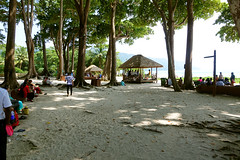After a tedious day long drive from Munsiyari, arriving at the salubrious ridge of Deenapani just before sundown was a great relief. The weather and the landscape that surrounded us refreshed us in a moment. Mind-blowing! Nestled among the middle spurs of the Himalayas, and surrounded by range upon range of higher mountains fading into the icy Great Himalayas, the ridge of Deenapani is the place where valley winds talk to each other. Far away towards the north towers the magnificent line of well-defined godly snowy peaks – the distinct Nanda Devi massif; flanked on west by the trident of Mahadeo, the Trishul and Panchachulis or the five hearths of the Gods towards the east. These famous snowy summits are the guardian angles of Kumaon.

Terraced fields from the balcony of the TRH. Please visit Flickr for more images of the region
Perched just above Almora – the ancient capital kingdom of Kumaon – the sparsely populated ridge of Deenapani is connected by a single road with the forests of Binsar on one side and the Almora city on the other. My initial memory connected with Deenapani was a hurriedly planned stopover for the night while returning from Badrinath in Garhwal many years ago just before the arrival of monsoons that season. I couldn’t wait to discover more out of the sylvan environs of the ridge. From then on, I relied on the peace of Deenapani and used this place as a transit destination to explore other parts of Kumaon. My most recent visit to Deenapani happened a few years later – earlier last month and this time I didn’t plan just a transit halt.
Just as my previous brief sojourns at Deenapani, this time as well we stayed at the KMVN TRH, the balconies of which face northwest and overlook a large part of the valley. The northern slopes of Deenapani ridge provide a good vantage point to observe the ingenious ways in which the hillsides of Kumaon are terraced and tilled for agriculture. Southwards the view is dominated by deep ravines and vast slopes of mountains all around with patches of cultivation surrounded by wilderness. Innumerable points of light shine out to announce the presence of habitations all around in a great vastness of the middle Himalayas as the fading daylight fills valleys and ravines with shadow.

The Crank’s Ridge. Leary, father of hippie movement also openly backed the use of psychedelic drugs, later popularised that the entire ridge is bestowed with special cosmic energy as it directly falls on the Van Allen belt.

The misty hillside. Today, the temple of Kasar Devi marks the end of the Crank’s ridge, formerly a haunt of artists, philosophers, spiritual leaders, poets and writers.

Remains of the cave shelter of Danish mystic Alfred Sorensen atop Crank’s Ridge. More at Flickr
When I was preparing for my Kailash Mansarovar Yatra (KMY) in 2015, I came across many interesting aspects originating from the Deenapani Ridge, a popular stopover on the traditional route of KMY. On my return to this hill many years after my initial vacation, this time I was searching for stories of Almora, Kasar Devi and Crank’s Ridge. Next day in the morning we walked the entire ridge length from Binsar junction on the east to the forest department office located westwards. As the horse saddle shaped Almora becomes visible, the ridge side ahead of Kasar Devi temple adorns a denser green cover comprising mostly pines and some oaks. Planted by the British, the pine cover around here gives quite a sylvan touch to the landscape around Almora.
Most travellers would agree with me in that Almora may not be a hill station in real terms but the town has everything to claim a culturally rich and a historic settlement status for itself. It also happens to be among the few mountain destinations in the Himalayas which were not founded by the British. The Chand dynasty ruled Kumaon for nearly three centuries from its capital at Almora before the British took over in 1815. The local architecture testifies Almora’s variable past. Blanketed by dense woods, the town’s sylvan charm have been attracting people for centuries. Its most illustrious visitors from the Indian landscape include Mahatma Gandhi, Gurudev Rabindranath Thakur, Swami Vivekananda and Jawaharlal Nehru, Uday Shankar, Zohra Sehgal and Guru Dutt, etc.

If you must then buy the famous Bal Mithai of Almora from Khim Singh Mohan Singh Rautela sweet shop on the Mall Road, Almora. Please visit Flickr for more images of the region
Nearly eight kilometres north of Almora, the area around Kasar Devi has been attracting spiritual seekers, curious visitors and celebrities from across the globe for a totally different reason. One of the earliest known pilgrims was Swami Vivekananda, who penned about having meditated at Kasar Devi in 1890 and made three trips to Almora. The ridge was once the residence of the renowned Tibetan Buddhism scholar Walter Evans-Wentz who wrote the Tibetan Book of Dead. His residence was later acquired by the colourful and theatrical couple Lama Anagarika Govinda, a Buddhist monk of Austrian origin who wrote the bestseller The Way of the White Clouds, and his wife Li Gotami, a Parsi artist and a photographer. Other popular mystics who visited and meditated here include Alfred Sorensen or Sunyata from Denmark and Richard Alpert aka Guru Ram Dass. The tranquil hillside also inspired Italian writer Tiziano Terzani who wrote The End is My Beginning.
Much of the “popular” spiritualism part of this tiny hill was swallowed up by the emergence of hippie cult in 1960s with the arrival of psychologist Timothy Leary, the father of hippie movement. Leary, who openly backed the use of psychedelic drugs, later popularised that the entire Kasar Devi ridge is bestowed with special cosmic energy as it directly falls on the Van Allen belt. As Leary sought advanced ways to attain spirituality, he started to try nudism even as he smoked freely available wild cannabis. He was the one who gave Crank’s Ridge its name. Today, the temple of Kasar Devi marks the end of the Crank’s ridge, formerly a haunt of artists, philosophers, spiritual leaders, poets and writers. The list includes the English novelist DH Lawrence, Cat Stevens, George Harrison, Bob Dylan, Ravi Shankar, Robert Thurman and Hollywood actress Uma Thurman and many more.

The Himalayan snow peaks – as observed from Binsar – obstructed by haze and clouds. More at Flickr
With an hour of daylight left, I head towards the old Kasar Devi temple that finds a mention in the Skanda Purana as a popular pilgrimage site. Legend has it that a renowned sorcerer and sage of olden times, who resided here, possessed such a supernatural power that he used to burn iron bars in his kitchen instead of wood. A pathway leaves the main road and ascends for about 600m to climb 70m to reach the temple at 1950m. An ancient Shiva temple is further up a few metres from the initial temple, now dedicated to Durga Devi. The spots where Swami Vivekananda is said to have meditated are marked by information boards. The top of the ridge commands a sweeping view of the Himalayas which is grand beyond description.

Rock inscriptions on a boulder near the temple. More images from the region at Flickr

The settlement of Almora as observed from the courtyard of the Kasar Devi temple. More at Flickr

A Blue Whistling Thrush atop the ridge. Please visit Flickr for more images of the region
Towards the west and south stretch the deep valleys of the Kosi and with the open low Hawalbagh plain in front, the valley is enclosed by wooded ranges of mountains. Down below, the villages appear like nests on terraced fields. The sky is still overcast. To the immediate north, a faint profile of the snowy Great Himalayan Range rises above the forests of Jandidhar. Soaking in the mesmerising sunset landscape, we turn back and head home for the night. The lush foliage tempers the fading sunlight filtering through tall straight pines. The earth everywhere is clothed with moist pine needles. Walking under a sky still aglow with orange and pink, I feel enamoured by the sweet smell of wildflowers and resinous odour of the pines. “Dating the silence of the hills, we are indeed walking in a Himalayan paradise”, I tell myself.

The setting sun as observed from the Kasar Devi Ridge. Please visit Flickr for more images of the region

A dramatic skyscape above the settlement of Deenapani. More images from the region at Flickr
We take a walking detour through the Deenapani settlement. The village folks are tending their livestock and are occupied with evening chores. Startled by our approach, fluffy hill dogs spookily follow us as troop of monkeys breaks away over the tree-tops and occasionally a partridge would fly noisily across the path. Back at the TRH, a wonderful nightscape awaits us. How pleasurable to sit in the balcony and drink in the pure Himalayan breeze as gaze strays from valley to valley and from distant range to range. With no hint of worldly noise to mar, an hour later, I am still sitting at the same spot in pensive mood as faintest breezes wander by.

A Kilmora outlet at the ridge. The shop sells good quality woolens. This and more from the region at Flickr

An outlet of Panchachuli Women Weavers at the Ridge. More images from the region at Flickr

A road side multi-cuisine cafe at Deenapani. Owing to the influx of travellers, there is no dearth of quality food joints at the Ridge. More images from the region at Flickr

The colourful interiors of Mohan’s Cafe at Deenapani. The cafe serves modern day quality north Indian food
Next day, we drive up a few kilometres (18 km) to the locally popular Chitai Temple. The temple is dedicated to one of the most popular deities of Kumaon – Golu Devta, God of justice – who, hypothetically, grants all wishes made by followers with a clear conscience. Intriguingly, Golu Devta’s chief shrine at Chitai is hung with uncountable bells and written petitions from followers seeking favourable answers to their wishes. As expected at any Hindu shrine, the market outside the temple sells all sort of holy souvenirs as well as naff ornaments and photographs.

The Chitai Golu Devta Temple at Almora. Please visit Flickr for more images of the region

The entrance to the Golu Devta Temple, the God of justice. Please visit Flickr for images of the region

Festooned with bells and petitions, the main shrine of the temple. More images at Flickr
Located a few more kilometres (22 km) up the valley towards Patal Bhuwaneshwar, we next reached the Rock Shelter of Lakhudiyaar by the bank of Suyal River, a painted and an ASI notified property. With a complete rock projecting out of a mountain face, the rock shelter dates back to the Stone Age. The ASI information board claims that most paintings are still intact. The inside walls and ceilings are painted in red, black and white resembling human beings, animals or trees. To sum up, I must admit that Deenapani actually is a destination with spiritual and travellers’ magnetism strong enough to attract wandering souls from faraway places.

As per the ASI information board, the Lakhudiyaar paintings are still very much intact. More at Flickr
Getting There
The ridge of Deenapani is 14 km from Almora and 18 km from Chitai on the Almora-Pithoragarh road.
Average Altitude: 1900m
Best time to visit: Winters and spring; avoid monsoons
Travel Lure: Himalayan views and heritage
Accommodation: Available
 bNomadic
bNomadic















Yet another place on my ‘to visit’ list. Sigh. Lovely pictures and super descriptions, as always. Thanks for posting this.
Thanks Mick! You have been a continuing source of encouragement. Very glad to know you liked the post. Keep visiting bNomadic 🙂
I shall, and thank you!
Misty mountains, places with ancient folklores and new age links – and stone age paintings. You take us places! 🙂 Thank you for this well written post with equally well matched photography. Hope you continue writing about such hidden gems from the Himalayas.
Thanks Ena! And for showering bNomadic with your love, support and appreciation. Well, I just try to bring out what I saw and experienced at the Himalayas. Keep visiting bNomadic 🙂
Adding this to my wishlist..beautifully written post
Thanks Jose! Glad you liked it. Keep visiting bNomadic for more travel stories
Lovely photographs and article.
Thanks Syam for stopping by the blog. Glad to know you liked it. Keep visiting bNomadic for more such travel stories 🙂
Lovely write up. I will be stalking your blog for some days now. 😀
Thanks! Hehe. Please do. It will be an honour for bNomadic 🙂
Awesome work.Just wanted to drop a comment and say I am new to your blog and really like what I am reading.Thanks for the share
Thanks! Keep visiting bNomadic for more such travel stories
Blogging is that the new poetry. I notice it terrific and howling in some ways in which.